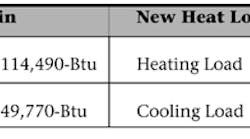Latest from Management
Sponsored
I'm sitting in a classroom taking the mandatory training class to be eligible to participate in the PA Keystone Help program that provides low-interest loans for folks to upgrade their home’s energy-efficiency. Most in attendance are insulation, general, window and door contractors. There are just a few mechanical contractors.
The instructor began by asking, "What's the first best investment: upgrade the shell by sealing infil-exfiltration air leaks, adding insulation, installing new windows and doors, or replacing the heating and air conditioning equipment? You can only afford to do one or the other."
I was seated in the front row. He called on me to give the answer! I knew what he wanted to hear and I didn't want to get off on the wrong foot, before class even started, because there was going to be a graded test at day's end. He had no idea that I'd previously crunched the numbers. Why lie when the truth will do.
"It depends," I said. "Let's use the average 2,250-sq.ft. home as the example. If you replace the heating and air conditioning equipment with modulating-condensing gas-fired and/or electric-powered inverter-drive variable-speed units for $15,000, and the building envelope upgrade costs $7,500, then the first best investment is the HVAC equipment. The fuel costs avoided will pay for the other upgrades and, here's the best part, as they make those upgrades — just in case they don't do them all at once — the variable-speed models will automatically adjust themselves to be right-sized for the lower heat loss/gain of the home."
As I spoke, I could see the look on his face clearly indicated he thought I was, shall we say, not playing with a full deck of cards.
"Well, I'd expect that since you're a mechanical contractor, but that's the wrong answer," he said.
"Hang on a minute," I said. "Let's say you do go all-in on the building envelope upgrade. Now you have HVAC equipment that's grossly oversized. The air conditioning will cool too quickly and fail to dehumidify properly while the heating will also short-cycle, causing both to operate at lower efficiencies. While they will think they're doing better because their fuel and power bills will be lower, they are now wasting a good portion of the energy they think they are conserving."
He clearly wanted to move on, so I shut up and kept quiet for the rest of the day.
The best way to illustrate the which-is-the-best-first-investment deal is to validate the findings using a few tools: Manual-J for heat loss/gain; blower-door test; actual current operating costs (to judge the accuracy of the first two); and the home's new conditions following the envelope upgrade. I'll use a 2,369-sq.ft. home where an independent energy-audit was performed before and after to reinforce the findings and a design-day-temperature of 0°F.
It's important to understand that old-style ON/OFF equipment is right-sized for just 10% of any given heating/cooling season. As outdoor weather temperatures moderate, the operating efficiencies suffer by as much as 40%. An appliance operating at 85% at 0°F outdoor air temperature may be operating as low as 45% at 70°F outdoor temperatures (see chart).
Modulating-condensing, ECM variable-speed motors, and inverter-driven equipment are right-sized for 90% or more of any given heating/cooling season and equipment operating efficiency will improve as outdoor weather moderates. Based on our past experience, weather-responsive modulation reduces operating costs by more than 30% when compared to ON/OFF fixed-speed appliances.
They avoid $1,330.75 and they will be blissfully unaware their equipment is short-cycling under adverse conditions that will shorten its life-span. If they bank the avoided costs, the savings will finally catch up to the HVAC upgrade costs in the 18th year.
They will avoid $1,527 and with some discipline can bank that towards the building envelope upgrades. The savings will catch up to the cost for upgrading the building envelope in the 8th year. In reality, they can re-invest incrementally in the building envelope upgrades and reach the ultimate goal of maximum energy-conservation in less time as costs for heating/cooling are reduced. Why? Because modulating equipment will resize itself to match the building’s heat loss/gain as those changes are implemented.
Dave Yates owns F.W. Behler, a contracting company in York, Pa. He can be reached by phone at 717/843-4920 or by e-mail at: [email protected].
All Dave Yates material in print and on Contractor's Web site is protected by Copyright 2011. Any reuse of this material (print or electronic) must first have the expressed written permission of Dave Yates and Contractor magazine. Please contact via email at: [email protected].
Dave Yates
Dave Yates material in print and on Contractor’s Website is protected by Copyright 2017. Any reuse of this material (print or electronic) must first have the expressed written permission of Dave Yates and Contractor magazine.


